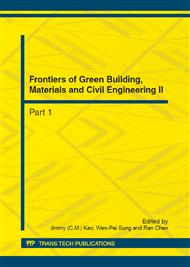[1]
S. N. Ghosh. Cement and concrete science & technology [M]. Thomas Telford, 1992 pp.174-175
Google Scholar
[2]
Jianzhuang Xiao. Recycled concrete (In Chinese) [M]. China Architecture & Building Press. (2008)
Google Scholar
[3]
Ravindra K. Dhir, Thomas D. Dyer, Judith E. Halliday. Sustainable concrete construction [M]. Thomas Telford. (2002)
Google Scholar
[4]
Enric Vázquez, Charles F. Hendriks, Gabriëlla M.T. Janssen. PRO40:International RILEM Conference on the Use of Recycled Materials in Buildings and Structures (Volume 2) RILEM Publications, (2004)
Google Scholar
[5]
Zhonghe Shui, Dongxing Xuan, Huiwen Wan, Beibei Cao. Rehydration reactivity of recycled mortar from concrete waste experienced to thermal treatment. Construction and building materials.22 (2008) 1723-1729
DOI: 10.1016/j.conbuildmat.2007.05.012
Google Scholar
[6]
Castellote M, Alonso C, Andrade C, Turrillas X, Campo J.Composition and microstructural changes of cement pastes upon heating, as studied by neutron diffraction. Cem Concr Res 2004;34(9):1633–44.
DOI: 10.1016/s0008-8846(03)00229-1
Google Scholar
[7]
Handoo SK, Agarwal S, Agarwal SK. Physical–chemical, mineralogical, and morphological characteristics of concrete exposed to elevated temperatures. Cem Concr Res 2002;32(7):1009–18.
DOI: 10.1016/s0008-8846(01)00736-0
Google Scholar
[8]
Phlilleo RE et al. Significance of test and properties of concrete and concrete making materials. New York: ASTM International; 1978. p.394.
Google Scholar
[9]
Zhonghe Shui, Dongxing Xuan, Wei Chen, Rui Yu, Rui Zhang. Cementitious characteristics of hydrated cement paste subjected to various dehydration temperatures Construction and Building Materials 23 (2009) 531–537.
DOI: 10.1016/j.conbuildmat.2007.10.016
Google Scholar
[10]
J.Bensted, P. Barnes. Structure and Performance of Cements (Srecyclednd Edition) [M]. Spon Press 2002. 27
Google Scholar
[11]
FUMINORI T. Towards completely recyclable concrete—Development of recycled-concrete [ J ]. Cement Concrete, 1995 (578) 1-8.
Google Scholar
[12]
JC/T 735—1996. Test method for burnability of cement raw meal
Google Scholar
[13]
Khadija Morsli, Angeles G. de la Torre, Mohammed Zahir, Miguel A.G. Aranda. Mineralogical phase analysis of alkali and sulfate bearing belite rich laboratory clinkers. Cem and Concr Res 37 (2007) 639-642
DOI: 10.1016/j.cemconres.2007.01.012
Google Scholar
[14]
Daisuke MINATO. Mechanism of carbonation process of γ-C2S and its effect on strength development
Google Scholar


